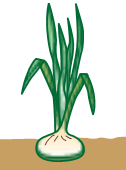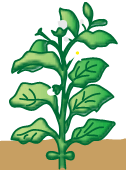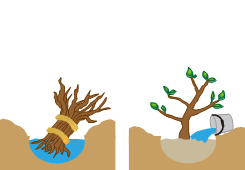In contrast to Fertilizers or Agrochemicals, Agricultural Biostimulant’s Main Ingredient is the Plant Growth Hormone Cytokinin, Extracted from Mushroom Mycelia
Agricultural Biostimulant contains a combination of cytokinin, a plant growth modulator, and amino acids for plant nutrition. The ingredients work in harmony to produce the effects observed in Agricultural Biostimulant.
In addition, it also promotes cell division, sugar and starch production by aiding in photosynthesis, encourages the growth of sprouts and buds, and has many beneficial effects for a variety of plants.
Applications of Agricultural Biostimulant
Usage varies depending on soil condition and crop type. The three applications below are considered general usage patterns:
❶
Leafy Vegetable Vegetative Growth
❷
Use in a Two-step program for Advancing from Vegetative Growth to Reproductive Growth
Rice, onions, cabbage, etc.
❸
Applications Where Vegetative Growth and Reproductive Growth occur at the same time:
Tomatoes, strawberries, etc.
❶
Leafy Vegetable Vegetative Growth
As a basal fertilizer for early growth stages
❷
Use in a Two-step program for Advancing from Vegetative Growth to Reproductive Growth
Rice, onions, cabbage, etc.
Usage split into various stages, such as rooting, leafing, fruiting, etc
❸
Applications Where Vegetative Growth and Reproductive Growth occur at the same time:
Tomatoes, strawberries, etc.
Used to ensure growth of leaves near fruit formation points
As a basal fertilizer for early growth stages
Usage split into various stages, such as rooting, leafing, fruiting, etc
Used to ensure growth of leaves near fruit formation points
*Overuse can lead to stunted growth. Please adhere to stated usage guidelines.
In recent years, nutritional value and functionality are becoming increasingly important for the general consumer. However, the majority of produce currently on the market is believed to be lower in nutritional value than in the past.
For example, the amount of vitamin C contained in broccoli was 160mg per 100g in 1982. In comparison, by 1993 this had dropped to just 83mg per 100g. This trend is not only limited to vitamin C, and a decrease has also been observed in calcium, iron, and other nutrients. The desire for products that are similarly shaped, long-lasting, and pleasant to the eye, in addition to modern year-round farming and over-use of fertilizer, is believed to be the cause of this.
The cytokinin contained within Agricultural Biostimulant encourages budding, rooting, photosynthesis, and allows plants to fully express their innate growth. Due to this, an increase in yields, nutritional value, and functionality can be expected.
Examples of Experimental Use
— Paddy Rice

Improvements in root extension and healthy shooting observed. Root growth promotion leads to increased nutrient uptake, and rapid anchoring with little shoot damage even when replanting in cold temperatures.
— Soy Bean, Adzuki Bean, Common Beans

3-leaf stage
Improvements in low-temperature resistance and number of knots. Growth of roots is also encouraged, along with increased nutrient uptake, leading to healthier growth.

Budding stage
Wilting of flowers and fruit buds is prevented, and number of bean pods increased. Healthy growth is encouraged, and photosynthesis is improved.
— Potatoes

Leafing
Encourages photosynthesis in early growth stages, and aids in formation of tubers. Increases the number of tubers present for each plant, and increases efficiency.

Budding stage
Encourages tuber growth, and increases amount of present starch. Three weeks after flowering tubers begin to rapidly enlarge.
— Onions

Application in 2-leaf stage
Increases rate of germination, and encourages growth in early stages

2~3 days before anchoring
Early root growth is encouraged, and low temperature resistance improved. Anchoring after planting improved.

6~7 leaf stage
Encourages bulb formation, and improves nutrient uptake and mesophyll growth.

Bulb Enlargement
Improves bulb density, and encourages growth.
*Use during sowing or at 2-leaf stage recommended
— Carrots

4~5 leaf stage
Leaf and stem growth encouraged, and photosynthesis promoted

Root vegetable enlargement
Root enlargement is encouraged, and quality increased. Time to harvest is also reduced.
— Cabbage, Chinese Cabbage

2~3 days before anchoring
Root formation is encouraged. Nutrient transfer is also improved, and anchoring promoted.

2 weeks post-anchoring
Root formation promoted, and increased photosynthesis raises produce quality.
*To prevent hormone imbalance, adhere to usage amount and application time
— Eggplant, Tomato, Cucumber

Potting
Encourages early root growth and leads to formation of healthy seedling

10 days prior to planting
Anchoring is improved, damage to plant is defended against, and low-temperature resistance improved.

Flowering
Prevents wilting, and encourages fruit formation.

Pre and mid-harvest
Protects against wilting and deformation due to prolonged growth, encourages photosynthesis, and improves produce quality.
— Spinach

Leafing
Improves low-temperature resistance, and encourages early-stage growth

5-leaf stage
Stem and leaf growth promoted, and leaf weight and colour improved. Improved produce quality

4-5 days prior to harvest
Produce freshness after harvest is remarkably improved
— Melon

Germination
Encourages growth of young shoots, and prevents root loss or stunted growth due to planting

2~3 days prior to planting
Root formation is encouraged, and anchoring improved.

5~6 leaf stage
Photosynthesis encouraged, and leaf size improved.
— Flowers, trees

Cutting
Encourages root formation, and improves anchoring

Saplings
Low-temperature resistance improved, and healthy growth promoted

Transplantation, planting
Encourages new root formation, protects against damage, and promotes anchoring

Growth stage
Root formation encouraged, and nutrient stock-piling promoted. Sagging trees are rejuvenated, and wintering improved.
About Agricultural Biostimulant

